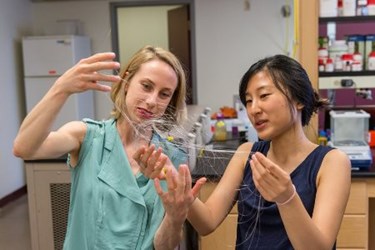Implanted Device Could Restore Movement For Paralyzed Patients

Scientists are working on an implantable neurological device that could reroute signals in the brain and allow patients paralyzed by stroke or spinal cord injury to move their limbs. A research team centered at the University of Washington (UW) has received a $16 million federal grant to help them achieve their goals, and the researchers believe the device could enter clinical trials within the next decade.
Many patients who have suffered spinal injuries can still form the intention of movement in their brains, but the pathways that communicate that intention to the spinal cord are too damaged to deliver the message.
“Our implantable devices aim to bridge such lost connections by decoding brain signals and stimulating the appropriate part of the spinal cord to enable the person to move again,” said Rajesh Rao, director for The Center for Sensorimotor Neural Engineering (CSNE), to the Puget Sound Business Journal (PSBJ).
The CSNE was established in 2011 with an $18.5 million grant from the National Science Foundation (NSF) and includes scientists from UW, as well as Massachusetts Institute of Technology (MIT), San Diego State University, and other partners. The NSF recently granted the CSNE another $16 million over four years to further ongoing research, which could lead to groundbreaking clinical devices within the next eight to 10 years, according to Rao.
In an abstract submitted to the NSF, the researchers wrote, “Today’s intelligent systems and robots can neither sense nor move like biological systems, and devices implanted in or interfaced with neural systems cannot process neural data robustly, safely, and in a functionally meaningful way. Doing so requires a critical missing ingredient: a novel, neural-inspired approach based on a deep understanding of how biological systems acquire and process information.”
Rao told The Seattle Times that, in order to bridge the gaps caused by neural damage, researchers had to develop “bidirectional” devices and complex computer algorithms that could collect and interpret brain signals and send their information on to other parts of the nervous systems.
These devices, said Rao, would introduce a “very targeted rehabilitation approach,” as opposed to traditional methods using pharmaceutical interventions or physical therapy, a “game-changer” for paralyzed patients.
Rao’s multidisciplinary team includes computer scientists, engineers, neuroscientists, and neurosurgeons who are studying new approaches to hardware that would prevent an implanted device from scarring over and malfunctioning. Additionally, they are working on ways to power the devices with batteries that will not need to be replaced.
The technology is being developed for patients paralyzed because of stroke or spinal cord injuries, but Rao sees eventual applications and treatments for progressive neurological diseases, such as Alzheimer’s and Parkinson’s.
In April, Medtronic selected the CNSE among a group of select universities to use the Activa PC+S Deep Brain Stimulation (DBS) system with patients suffering with essential tremor, reported UW Today. UW scientists are working alongside Medtronic to develop methods for increasing the device’s battery life and ways to allow the user to adjust the stimulation using voluntary neural commands.
Rao called the CNSE’s work a collaboration between academic and industry partners, and told PSBJ that their goal is to demonstrate proof-of-concept devices within the next five years.
